Auckland, New Zealand May 2, 2016-May 5, 2016
We departed Papeete May 1st at 5:50 PM on Air New Zealand and would arrive in Auckland, New Zealand May 2nd at 9:15 PM (12 hours ahead of Toronto) after crossing the International Date Line. Kia Ora = Welcome!

After essentially losing a day and the clocks shifting back 2 more hours from Tahiti to New Zealand, we were now 14 hours ahead of home (Toronto, Canada). Bottom line, we were exhausted! Luckily, passing through the airport to baggage claim via electronic self-customs expedited the process! Travelling from Auckland Airport to the CBD (Central Business District) is about 21km and the Skybus runs every 10-14minutes, 24hours/day, 7days/week. We were all too happy to arrive safely via sky city bus ($16NZD per person vs $50-100 NZD Taxi) to our first VRBO rental at Loft 2G… and sleep!
We picked up a Free Arrival Guide full of tips, discounts, and deals for New Zealand covering the North and South Island. We had opted to utilize our Rogers International Roaming charge ($10/Day for 10 days = capped at $100/month) so that we could keep in touch with family and friends. There are options to purchase travel SIM cards from 2degrees/Vodaphone and other cell phone companies preloaded for $29 and up.
You can spend a lot of time researching your travels, however, Google may not always provide ALL the information or businesses that you may be looking for. A prime example for us was Jucy Car Rental. While in Canada searching for car rental companies, Jucy did not show up in our searches on Google. We found out about the company while driving around New Zealand and seeing the bright green and purple camper vans. We would be very happy we did, because it would later allow us to meet a fellow traveller in Australia.
From a historical perspective, the Maori people migrated from Polynesia to New Zealand and formed a unique culture and language around the 1300s. In 1840, the Watangi Treaty was signed in the Bay of Islands by the Maori people and the European settlers to keep the peace. The treaty is now looked at as a founding document for the nation of New Zealand. After visiting French Polynesia this year, we were able to see the similarities between Maori and Polynesian cultures.
The city of Rotorua is the heart of Maori cultural tourism and offers the best opportunity to learn about their amazing culture. There are also geothermal attractions and the beautiful Lake Rotorua to check out. During our first visit to New Zealand in 2006, we visited Rotorua for the day and spent a few hours enjoying the city, Maori culture, and geothermal attractions (Warning - it will smell like rotten eggs [sulphur]).
2016.05.03 - Auckland (and Waiheke Island)
May 3rd would be our first full day in Auckland. The VRBO owner had kindly left eggs, which we fried and paired with gluten free toast. After breakfast, we found the iSite (tourist information centre with locations across New Zealand) on the lower level of the Sky City Hotel and purchased groceries from Countdown (request the traveller discount card). For less than $120NZD we purchased enough food to provide each of us with 3 meals per day for the next 3 days; very cost effective and well below our estimated $75 NZD per day food budget. It’s a good thing because we would soon realize that we had failed to account for the nearly $2 NZD per litre fuel cost for driving in NZ. Ouch!
Originally, this day was planned for rest and laundry, until we caught wind of Waiheke Island. Waiheke Island is one of 10 recognized wine regions in New Zealand (NZ) and home to multiple wineries accessible by local bus, bicycle, or foot if you’re feeling energetic. We spent the afternoon exploring Waiheke after purchasing the Fullers ferry tickets plus all day bus pass ($45NZD per person), which allowed us to hop on an off any of the buses on the island. During the beautiful 40 minute ferry ride departing from Auckland and reaching Matiatia Bay, Waiheke, we passed by Auckland’s largest volcano Rangitoto on the way. Instead of visiting wineries with the self-guided wine trail maps, we opted to visit several pristine beaches and bays along the 133km coastline. The weather was absolutely perfect! We found ourselves relaxed and at ease walking alongside the roads when we weren't taking in the scenery by bus. We were so captured by the island’s beauty, that we nearly forgot about our Auckland car rental reservation. Instead of rushing back, we simply rescheduled the pickup! As the day came to an end, Onetangi Bay was the perfect place to take in the sunset before spending the return ferry ride stargazing on the otherwise empty top deck. Sweater required, but very romantic! We are forever grateful for the recommendation to visit Waiheke Island and would happily return. Next time we will stay longer and buy wine! The beaches, vineyards, cafes, and restaurants are both spectacular and plentiful. And importantly, we were unable to find and purchase wine from this region anywhere else in NZ.


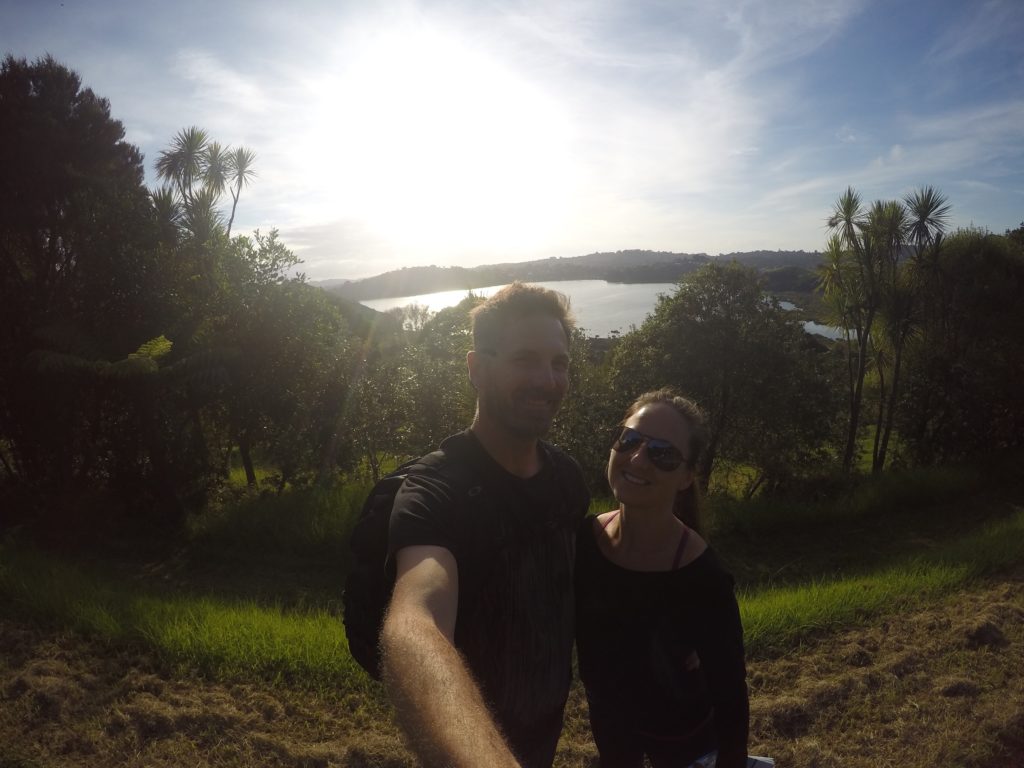



2016.05.04 Auckland to Cape Reinga
Oops… we slept in. The time change, sleep deprivation, and Andrew’s battle with a respiratory virus caught while on the cruise were all to blame, but would not defeat us today. We had plans to drive the 5 hours from Auckland to Cape Reinga (the northern tip of New Zealand where the Tasman Sea and Pacific Ocean meet). After breakfast we walked nearly 45 minutes uphill to Apex Car Rental. It wasn’t supposed to take so long, but Google maps decided to suggest a non-existent route in the CBD (Central Business District) that forced us to back track. So Google maps, when you read this, Albert Street and Shortland Street do not intersect and neither do Parliament Street and Beach Road.

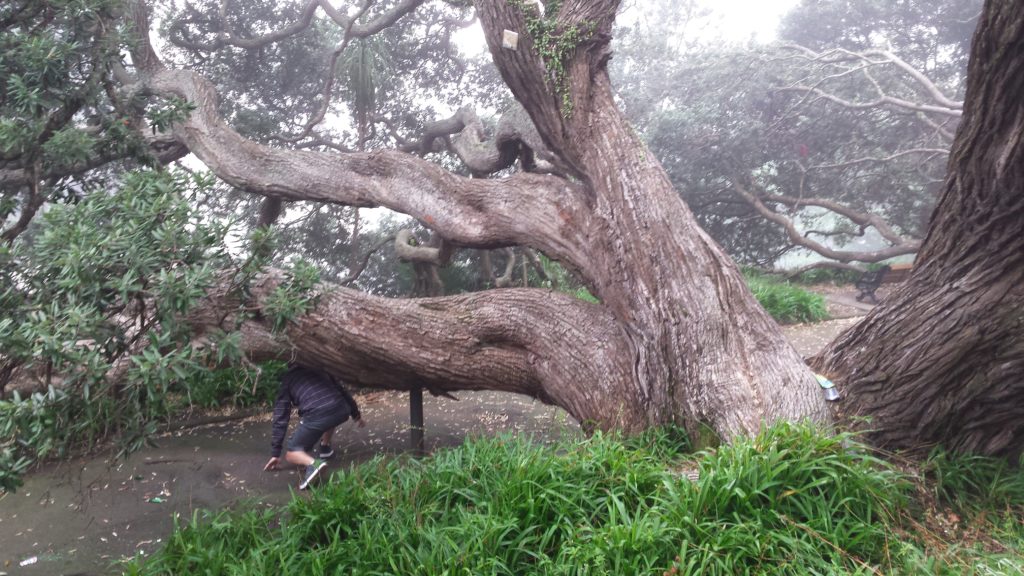
At Apex Car Rental our jaws dropped as we laid eyes on our rental car. The Subaru Legacy had 3 tires and the front bumper was hanging off. Well, not quite… but it might as well have been for all the damage on the vehicle. Welcome to Apex budget rental car company, where Avis cars go to die. We expressed our concerns that there was not enough time in the day or space on the inspection sheet to mark all the damage. We even offered to take a downgrade to a smaller vehicle if it wouldn’t fall apart. Thirty minutes later we left the lot in a less damaged Subaru Legacy and were reassured it was only major, not minor damage that Apex was concerned about.
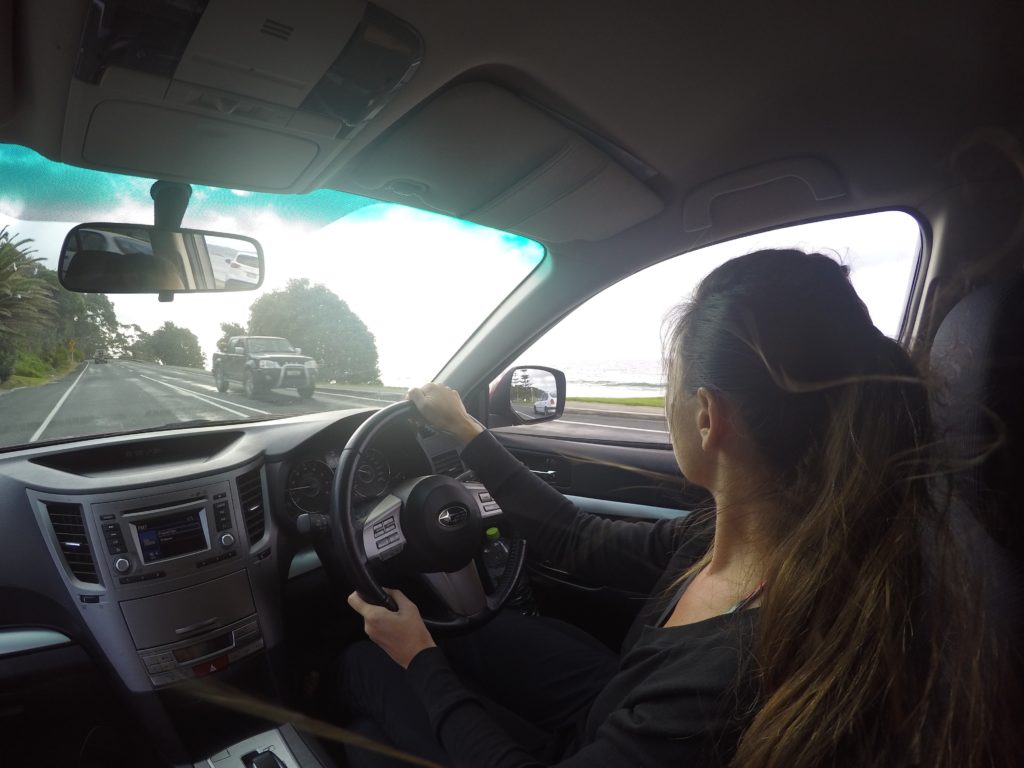
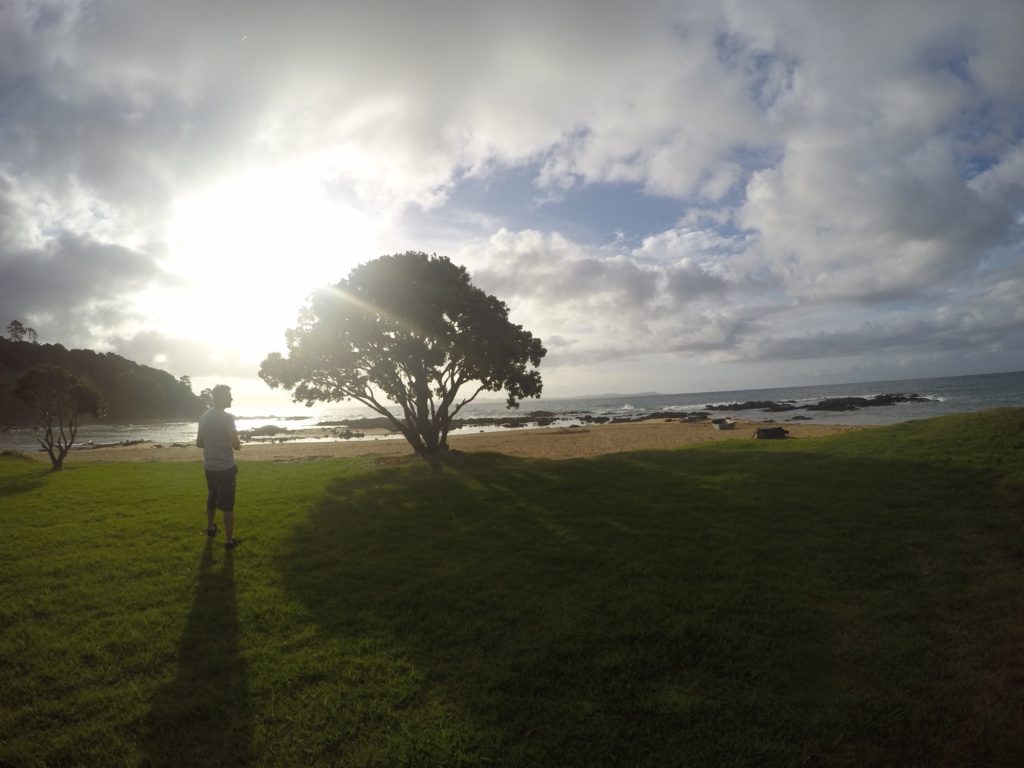
Six hours later, Krissy (driving on the left side of the road for the first time) raced against the setting sun to reach Cape Reinga with just enough light left to see the meeting of the Tasman Sea and Pacific Ocean. Believing we were making good time, and disregarding the multiple road signs suggesting travellers should “give yourself extra time, as it make take longer than you think” to reach your destination, we had stopped in Bay of Islands (Paihia) for lunch. It was here where several sparrows decided Krissy’s face was the perfect place to drop their poop from the branch above. Clearly Paihia’s inviting benches beneath the trees are not the best choice for a picnic lunch.
Another hard learned lesson, the cautionary signage isn’t a joke. For the most part, New Zealand is an Obsessive Compulsive person’s dream with everything manicured and in line… except the roads. The roads are endlessly sharp curving with steep inclines and declines (a go kart dream track) paired with a scarily aggressive speed limit of 100km/h for roads with steep drop-offs. In Canada, if a destination is 100km away and we travel on the highway at 100km/h, we get to our destination in 1 hour. In New Zealand, if your destination is 100km away and you try to travel at 100km/h, you will die before you get there; if however, you value your life and drive reasonably, it may take nearly double the time to reach your destination, especially if driving in the pitch dark as we did on the way home that night.

We would recommend leaving early in the morning and breaking up the drive by pausing in Whangarei (for both fuel and the Whangarei waterfall) and again in Paihia or Cable Bay. Most importantly, do not assume the road down the middle of the North Island (Hwy 1) will be straight and get you home in the dark faster than the coastal route because it is not and it will not! A full day of lessons learned.

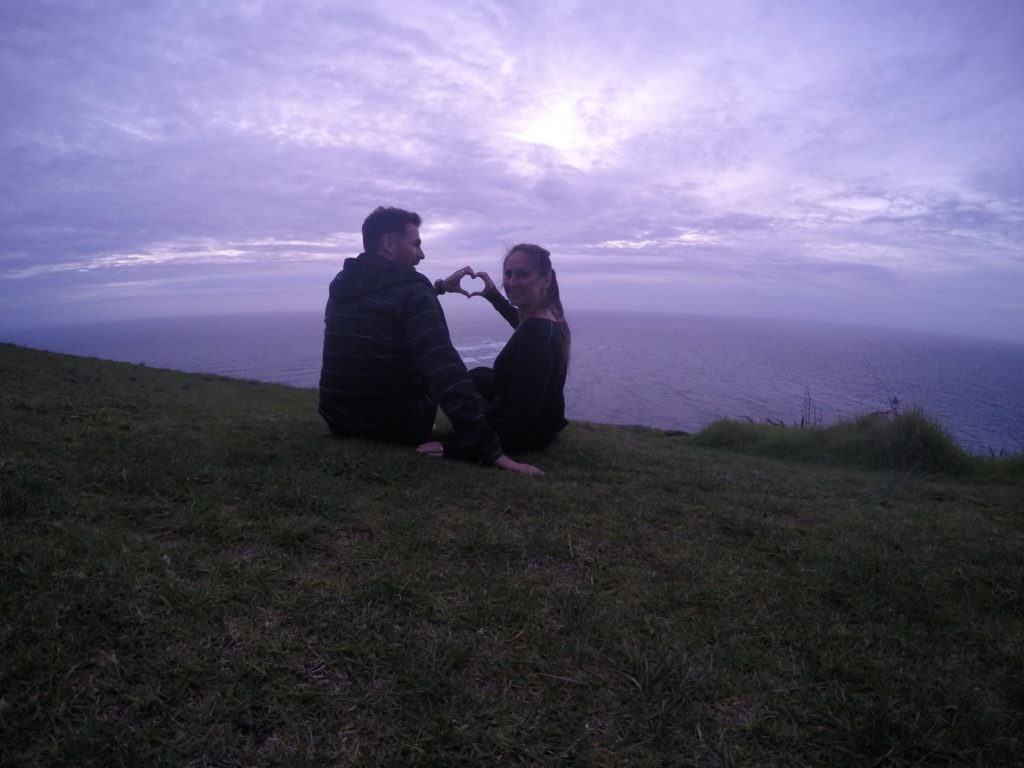
2016.05.05 Auckland to Taupo (Lake Taupo - pronounced “toe-paw”)
Today’s game plan included driving from Auckland to Matamata’s Hobbiton (the movie set from Lord of the Rings and The Hobbit), followed by the Waitomo Glow Worm Caves before finishing the drive to Lake Taupo for the night.
We left Auckland as the sun was rising to arrive at the Shire’s Rest Cafe of the Hobbiton Movie Set (www.hobbitontours.com) with just enough time to make our scheduled tour. Hobbiton is situated on a working farm with about 13,000 sheep. The original owner has passed the farm down to his sons; one son runs the farm, and the other son (accountant) runs the tourism component. The 2 hour tour starts at the Shire’s Rest and we were bussed onto the rolling green hills of the farm to Hobbiton.
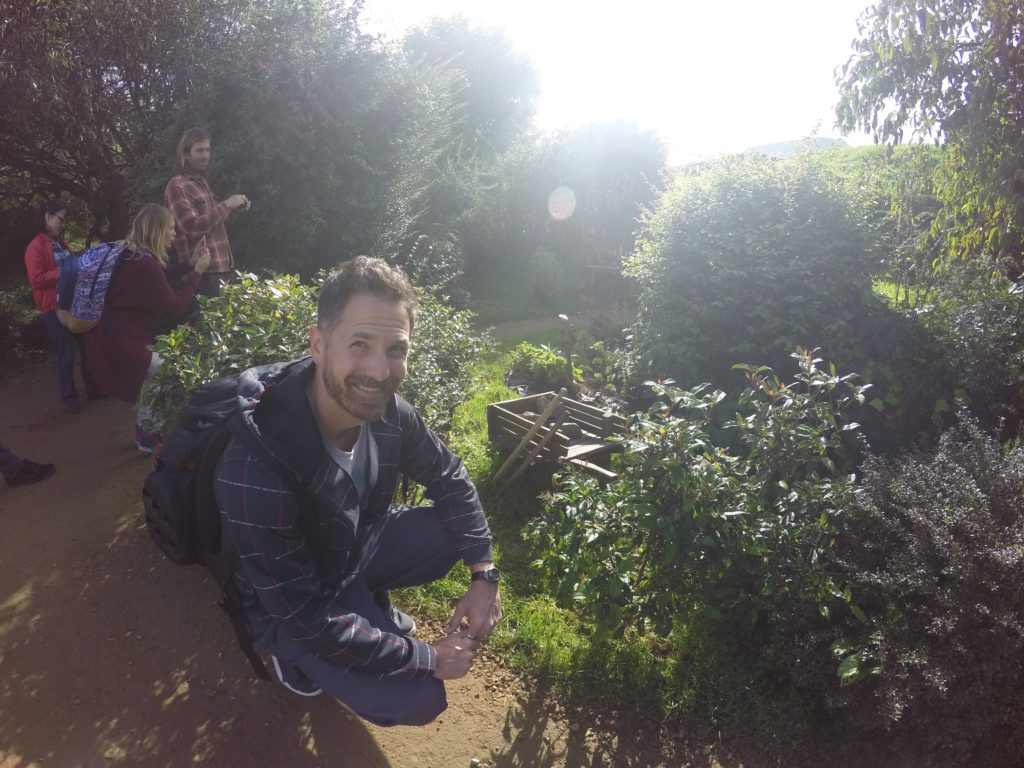



The movie set was complete with Hobbit holes, living gardens, bridges, a mill, and the Green Dragon Inn - it was amazing to set foot in the world J.R.R Tolkien created and Sir Peter Jackson brought to life. The guided tour takes you through the village past Hobbit holes, where we stopped for photos at every doorway. Krissy was in love with everything miniature about the set. We learned that none of the Hobbit holes were actually inhabitable - just a facade and doorway. We were told about (and maybe checked and took pictures in) a few of the Hobbit hole doors that had openings to a small space about the size of a closet…
Bag End (Bilbo Baggins home in the movies) was an obvious highlight with everything intact from the door to the sign on the gate to the large tree above. Unfortunately, no one is allowed access up to the front door of Bag End so photos were taken from the path below.



We did start noticing another couple that was a little mischievous…and it rubbed off on us. We found ourselves taking photos of each other as we pushed the boundaries of what we were allowed to do, or touch, much to the dismay of our guide.


The tour’s last stop was The Green Dragon Inn (functional) with real Hobbit ales and Hobbit fare. Since Krissy is gluten free, I was able to sample 2 of the delicious Hobbit ales. After being captured in (…okay I photo bombed) an Asian tourist's pictures, it was time to head back to the Shire’s Rest to drive the 1.5 hours to the Waitomo Caves (www.waitomo.com).
While awaiting our cave tours, the rain started, and we witnessed an unexpected sight - a large group of cattle being herded along the highway, with one cow veering off course and coming down the path intended for the cave tours! It took some unexpected shouting and coercing before the cow moo-ved back with the herd and they were all moo-ving along (haha).
We opted for the Waitomo Glowworm Caves and Ruakuri Cave tours and we were not disappointed. For the Waitomo Glowworm Caves tour, you descend into the cave passing through the limestone Cathedral Cave. Here, exceptional acoustics exist. Guests are invited to sing before the guide shares details about the history of the caves. The caves were discovered by a Maori Chief and tours started back in the 1880s. Next, the glowworms… via boat in the dark. The guide stood at the bow of the boat and using suspended cables, pulled us along a river passing through the caves. Everyone must adhere to the rules: absolutely no photographs and no loud noises or talking, as the glowworms would be disturbed and the vibrant light display would be disrupted. It felt surreal as we slipped along the water silently starring at thousands of glowworms on cave walls and ceilings… an experience similar to looking up at the stars.

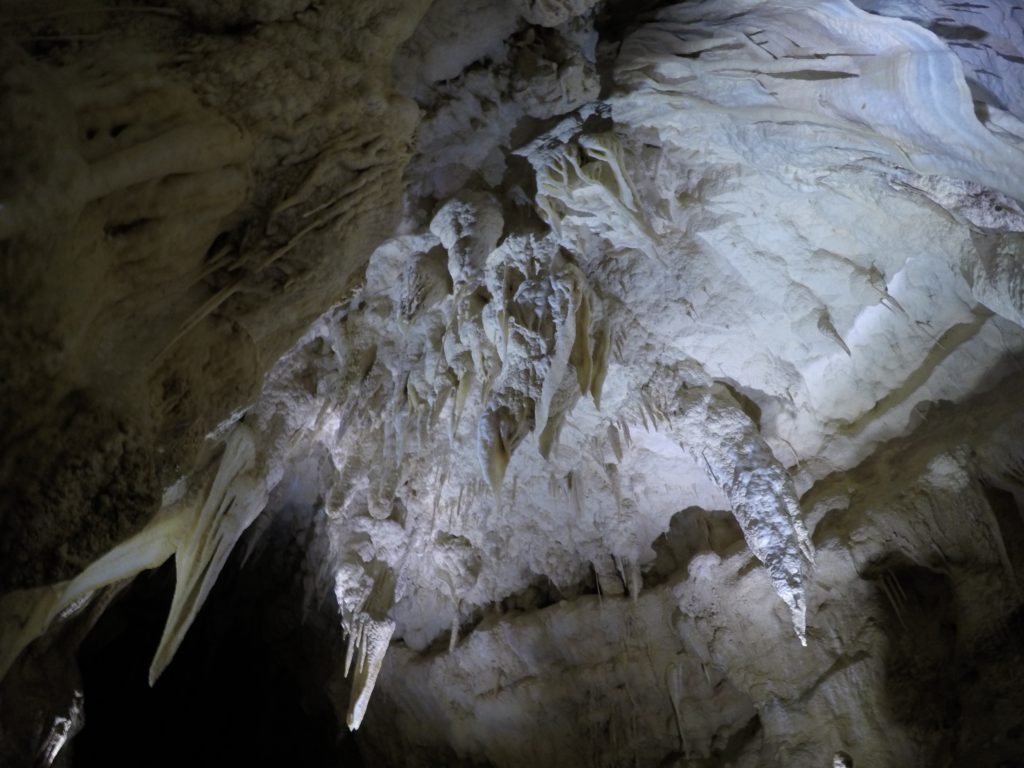

The Ruakuri Cave (Rua = Den Kuri = Dog) was next and Rudy, the guide and driver between caves, was both informative and amusing. Today’s tour group was much smaller, about 6 people in total, which made for an intimate experience. The entrance of the cave had been designed to protect a Wahi Tapu (sacred area) and it was an engineered spiral ramp that went deep into the earth. Impressively, the spiral ramp makes this one of the only wheelchair accessible cave systems in the world.
Another highlight of the Ruakuri Cave, was the opportunity to get within a few feet of glowworms. They are captivating glowing creatures, that is until you learn that you are actually staring at a maggot that will eat anything it traps, including its’ relatives! The glowworm is a larvae (or maggot) that eventually turns into a fly and leaves the cave. The glowworms produce a bioluminescence (light) to lure prey into the sticky “fishing line” they dangle below them. Once the prey has been caught, it is “reeled” in and eaten. Yum… who’s hungry?
If we had more time at Waitomo Caves, we would have checked out the Legendary Black Water Rafting Co. It sounds like an intense ride that offers the opportunity to suit up and cruise the black water that flows through the caves via inner tube! And… there is also a dry caving high rope trip available. Whatever you choose, you will not be disappointed coming to Waitomo Caves.
We spent the early evening driving through thick fog along winding mountain ranges to reach Taupo (“toe-paw”) where we checked in to the Hilton Hotel (the only 5 star international hotel by Lake Taupo) and enjoyed the knowledge and energy of the reception attendant Cody - an adventure seeker!
2016.05.06 Lake Taupo to Wellington
Feeling refreshed, we started our day with a run along the waterfront (Lake Terrace) of Lake Taupo; New Zealand’s largest fresh water lake (about the size of Singapore). It was also the perfect place to enjoy breakfast. This region has a volcanic past and natural geothermal attractions are abundant. The lake itself is in the caldera of the Taupo Volcano and there is still underwater hydrothermal activity near the Horomatangi vent. If we had more time, we would have checked out some of the geothermal attractions, like Craters of the Moon, Orakei Korako, Taupo DeBretts Hot Springs, or Wairakei Terraces Hot Pools.
Equally important to the region’s notoriety, the extreme adrenaline junkie attractions including sky diving, bungy jumping, jet boating, water sports, rafting, and many more. For a full list of extreme shenanigans check out www.greatlaketaupo.com.
Before leaving Lake Taupo for Wellington, we found the Body Fuel Cafe. Not only was the award winning coffee memorable, but the taste and array of gluten free and vegan options was unforgettable. New to us was feijoa. The owner provided us with samples of the small green fruit with a sweet aromatic flavour and mild kiwi-like tang. We fell in love with the featured feijoa and passionfruit gluten free muffin and even double backed for a second serving before leaving.
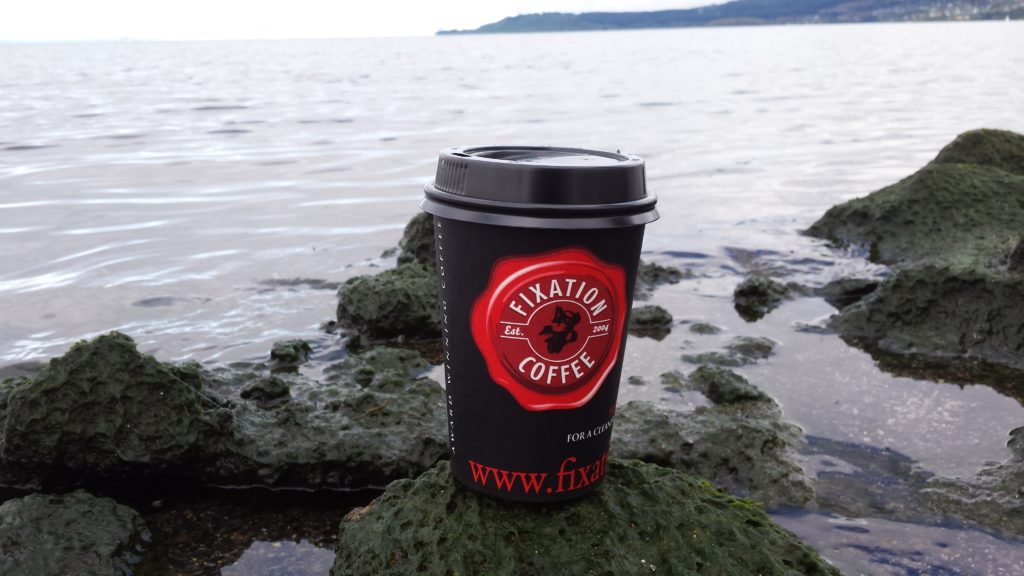

On route to Wellington (the capital of New Zealand), we drove through part of New Zealand’s first National Park - Tongariro National Park (1887) with dual world heritage status due to the Maori Cultural roots and natural beauty. The park boasts 3 mountains: Mt Ruapehu, Mt Tangariro, and Mt Ngauruhoe (Mount Doom in the Lord of the Rings Trilogy). If we had more time (a repeating theme for NZ), we would have done the weather dependent Tongariro Alpine Crossing, which is described as one of the best full day hikes in NZ. The 17km hike takes you past craters, scattered pumice, active volcanoes, and other beautiful landscapes with breathtaking views.
As we continued south toward Wellington (5h drive), we drove past varying landscape ranging from military training areas with desert-like conditions to the tall rolling hills dotted with sheep and cattle. By 6pm we arrived in Wellington. We checked into the Novotel and parked next door ($20NZD per night). We stepped into the lobby elevator, the doors closed behind us and we selected our floor… we patiently waited, but the elevator stood still. I found myself thinking... Maybe we should make out? or... Maybe we should call for help? Minutes later, the doors opened, we looked out at the lobby and the passing manager, who realized by our confused glances that we had failed to swipe our room key to activate the elevator. Apparently most of the world, apart from North America, uses room keys to ignite elevators into action.
That night, the weather was cool, but comfortable, and made for a most enjoyable walk through the city streets and intricate alleyways in search of a liquor and grocery store. Wellington should definitely have been a multi-day destination!
2016.05.07 Wellington, North Island to Christchurch, South Island
An early departure and 20 minute drive to arrive by 7 AM to the ferry terminal to shift from Wellington (North Island) to Picton (South Island) aboard the Interislander Ship: Kaitaki with 8:45 AM departure. It proved important to pre-book ferry transfers in advance (Apex included ferry tickets with our car rental), as waiting to the last minute may cause you to miss a ferry because they sell out quickly. After relaxing inside the ferry for the first 2 hours, we braved the cold wind for the final hour to witness the impressive sights of the narrower passage!
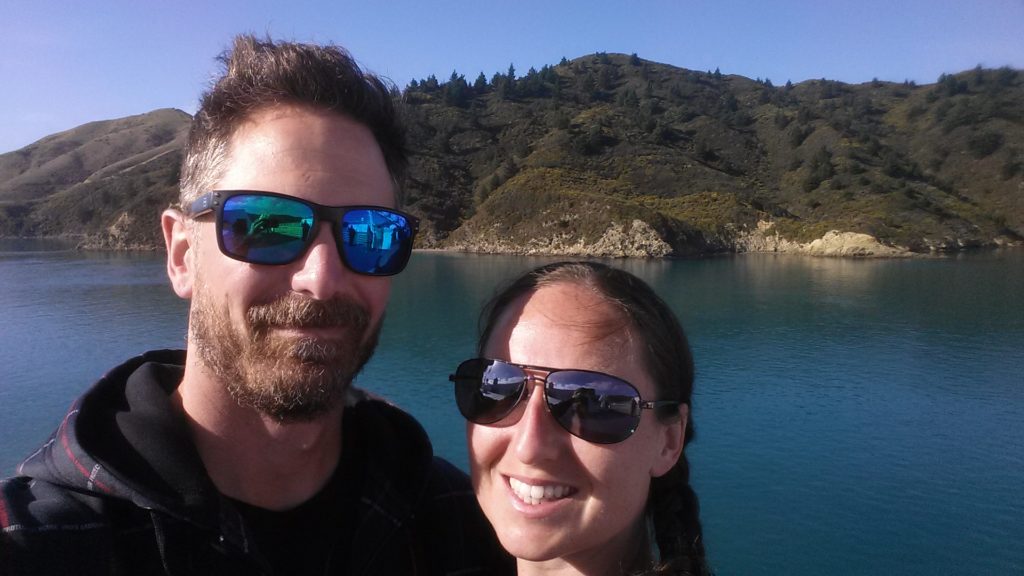

From Picton (South Island, NZ), we drove south towards Kaikoura, along the East Coast. Kaikoura is known for its abundant sea life (marine reserve and whale sanctuary), its rich Maori and whaling history, and European settlement. The abundance of sea life is a result of the Hikurangi Trench; a trench that made whaling a big part of Kaikoura’s history. In Maori, ‘kai’ means food and ‘koura’ means crayfish. We were fortunate to see southern fur seals basking in the sun and swimming around the shallow waters off the shore while driving near and along the Kaikoura peninsula.
If you have time to get out on the water, there are sperm whale watching tours that depart every day, and there is a chance to see or swim with dolphins. If you have time to explore on land, know that Kaikoura is on the eastern edge of the Seaward Kaikoura mountains; part of the southern alps. The mountain we suggest you check out is Mount Fyffe, popular for hiking and named after the first family to settle in Kaikoura.

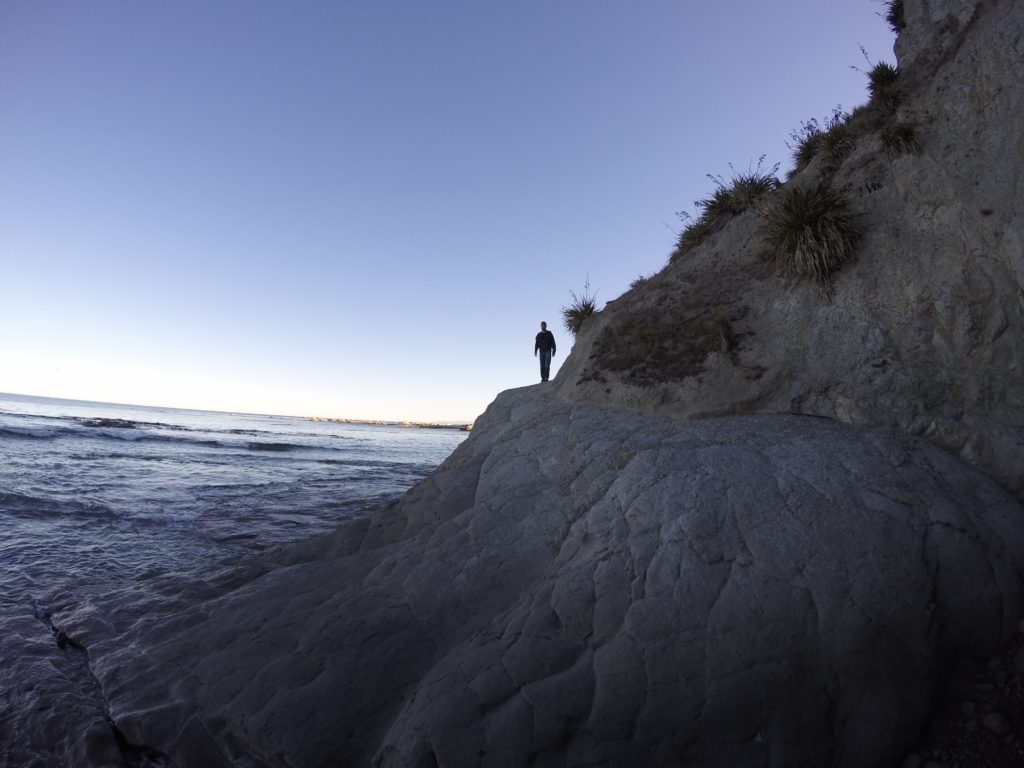

Continuing south, we reached Christchurch 2.5 hours later. Christchurch is the largest city on the South Island with Maori name ‘Otautahi’ (the place of Tautahi). Prior to 1930, the area was referred to as Karaitiana, a conversion of the English word Christian.
From 2010 to 2012 there were a number of earthquakes of large magnitude and a number of after shocks. As a result, Christchurch has been dubbed Quake Town and Shaky City. A large number of people lost their lives, and approximately 1500 buildings were damaged or destroyed. From September 2010 to September 2014 there were approximately 4,558 earthquakes.



We stayed the night and used TripAdvisor to find a Greek restaurant (Costas Taverna). It proved to be a popular destination with impressive food; making reservations helped. It was strange to be admired for our Canadian accent by the servers. It elicited conversation that highlighted amusing NZ slang like “sweet as” (as in sweet as pie, not sweet ass like we had interpreted it to mean), “yeah nah” (meaning no, not yes), and “no worries”.
During the catch phrase exchanges, we caught a glimpse of the subtle rivalry between New Zealand (Kiwis) and Australia (Aussies). Don’t tell the Aussies, but the Kiwis are claiming they started “no worries”… let’s keep that our little secret.
On a more serious note, we were also given insight into the catastrophic and enduring consequences the earthquakes have had on the people living in Chistchurch. Alex, our waitress, pointed out that the people remain emotionally scarred from the loss of life and damage caused by the earthquakes. The city inhabitants do not appreciate tourists taking photographs of the remaining red zone ruins and want Christchurch to be seen as rising from the rubble. That night we drifted to sleep feeling hopeful for the city, but also hoping not to experience an earthquake.
2016.05.08 Christchurch to Queenstown
From Christchurch to Queenstown on an optimal clear blue sky drive day. Refusing to overspend on breakfast, we stopped at a convenience store for yogurt and bananas, only to happen upon - Rocktopus (a human hamster wheel) - a must try that would probably be illegal in Canada. It was good for a few laughs!


We made it to Tekapo (Lake Tekapo, “Window to the Universe”) in time for lunch by the lake after stopping by the tourist information centre. Feeling silly and creative, we took pictures atop a large rock. Later that evening we would realize, our self-proclaimed incredible shots, were really just excellent images of a bird poop covered rock! Lucky (or not) for you, we do not subscribe to the idea that ALL your travel photos will be picture perfect, so we are definitely going to use them (for your amusement)! Consider it a lesson in the beauty and humour of imperfection. And… sometimes it’s important to view your images on site… or maybe just put the camera down and embrace the surrounding beauty from time to time.
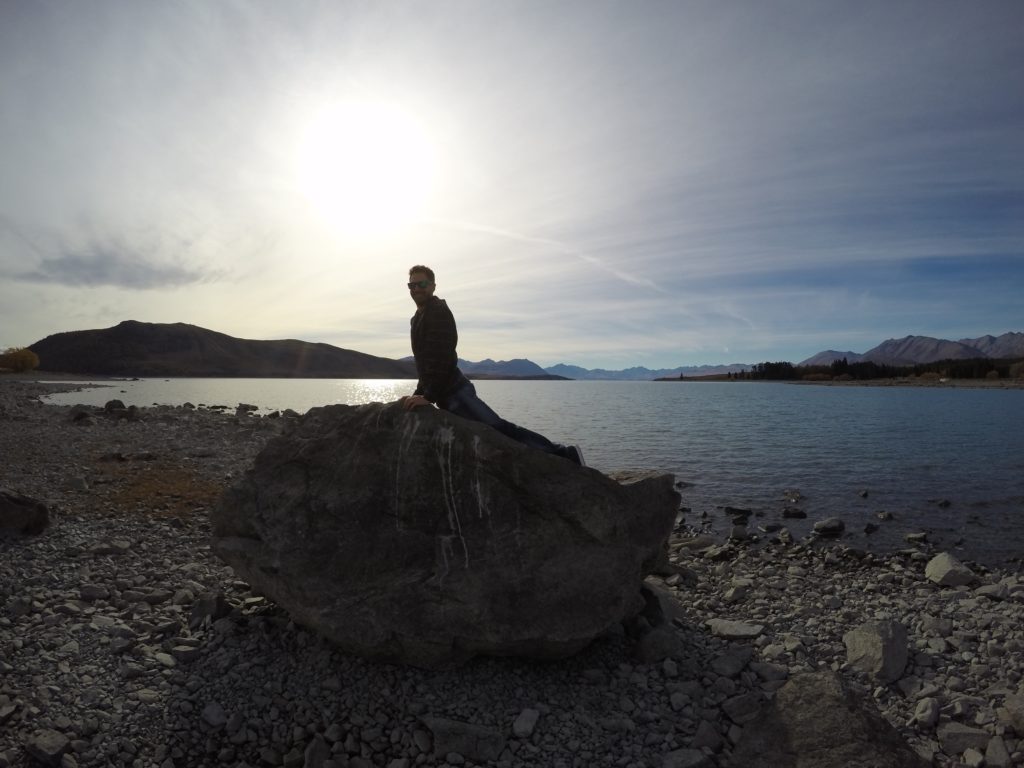

We learned that Lake Tekapo is home to the Aoraki Mackenzie International Dark Sky Reserve; the largest dark sky reserve in the world. From the Mount John Observatory, there are a number of day and night tours that you can sign up for, but obviously a night time tour would be amazing. Lake Tekapo is perfectly picturesque during the day, but we were disappointed not to have time for a Dark Sky Reserve stargazing tour.
What we weren’t disappointed with was our decision to drive toward Lake Wanaka. This postcard perfect lake has the most impressively clear turquoise water with the snow capped Mount Aspiring (National Park) visible on the horizon. We parked and got closer, Andrew found it irresistible not to skip stones with all the flat rocks lining the shore. While I demonstrated my lack of coordination, Andrew prided himself on quite possibly breaking a Guinness Book record for most stone skips, but I guess we will have to review his video…


The timing worked out well because driving into Queenstown at dusk was an amazing sight. The city is nestled along Lake Wakatipu, at the bottom of a small mountain range and it was dotted with city lights. The landscape surrounding the city leaves you with the distinct impression that it was carved by glaciers thousands of years ago... and left behind - a unique European village.
Queenstown, similar to Lake Taupo (North Island), has both breathtaking beauty and adrenaline stimulating experiences. It is an adventure seekers dream destination with the world’s first bungy jumping bridge, river surfing, jet boating, heli-skiing, and snowboarding to name a few. If you prefer a more relaxed pace, spas, wineries, and other low impact experiences abound.
2016.05.09 Queenstown to Milford Sound (and back)
Based on a friend’s recommendation, we pre-booked a cruise in Milford Sound (Piopiotahi) months ago. Of course, when you pre-book an excursion, you never get a choice in weather. On this day, we woke at 5 AM to the sound of rain. Driving in NZ on a clear sunny day seemed treacherous enough at times; the thought of driving 3.5 hours (per Google Maps) along NZ’s winding roads in the dark with heavy rain was definitely unnerving. We just hoped that as we left Queenstown that perhaps the rain would lighten and the drive would become easier… oh so optimistically wrong!
We were nearly an hour into our drive and barely outside of Queenstown. The rain increased in intensity, the wipers were on the highest setting and still we could barely see. The Kiwis, not seeming to notice the treacherous conditions, were passing in the dark around blind corners. The further from Queenstown we drove, the more patchy the cell signal became. We pulled over, maybe into a farmer’s field?, and called Southern Discoveries (www.southerndiscoveries.co.nz) to let them know we would be late and they graciously changed our cruise time from 9:45 AM to 12:15 PM. We weighed our options - push through and risk our lives for Milford Sound or turn back and risk our lives plus forfeit several hundred non-refundable dollars. The frugal adventurous option won and we pushed through toward Milford Sound. We would soon be rewarded for our courage as eventually it stopped raining, and the landscape was absolutely stunning: winding roads, mountains, temporary rivers and water falls cascading down the rock faces all because of the heavy rains.
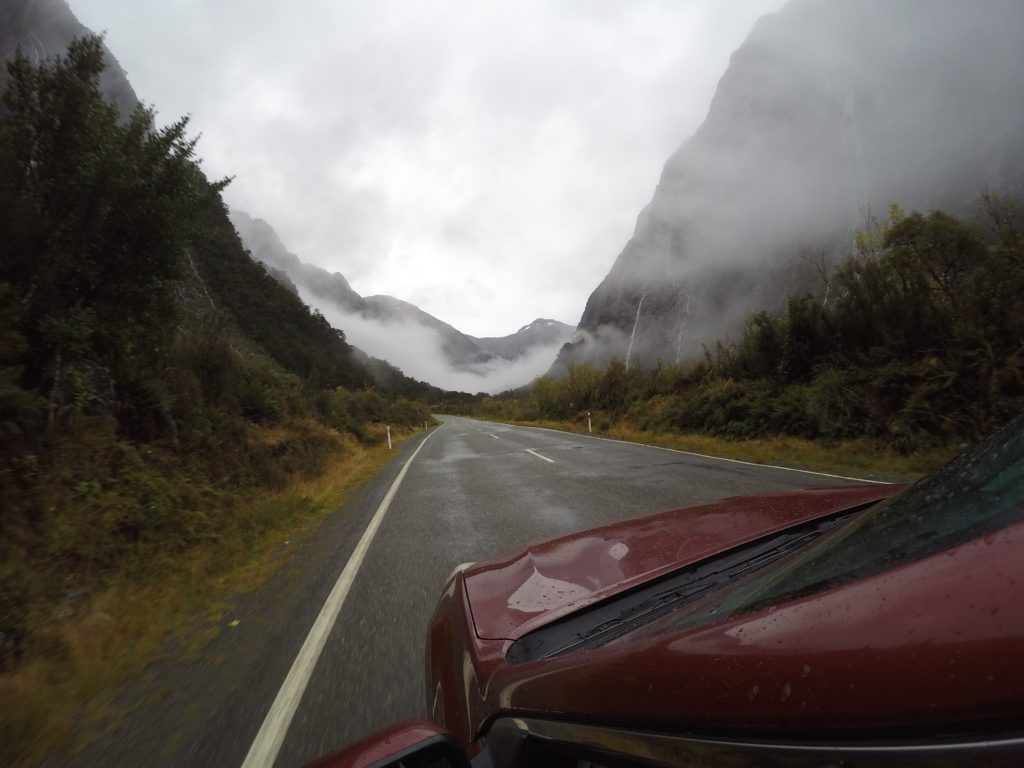
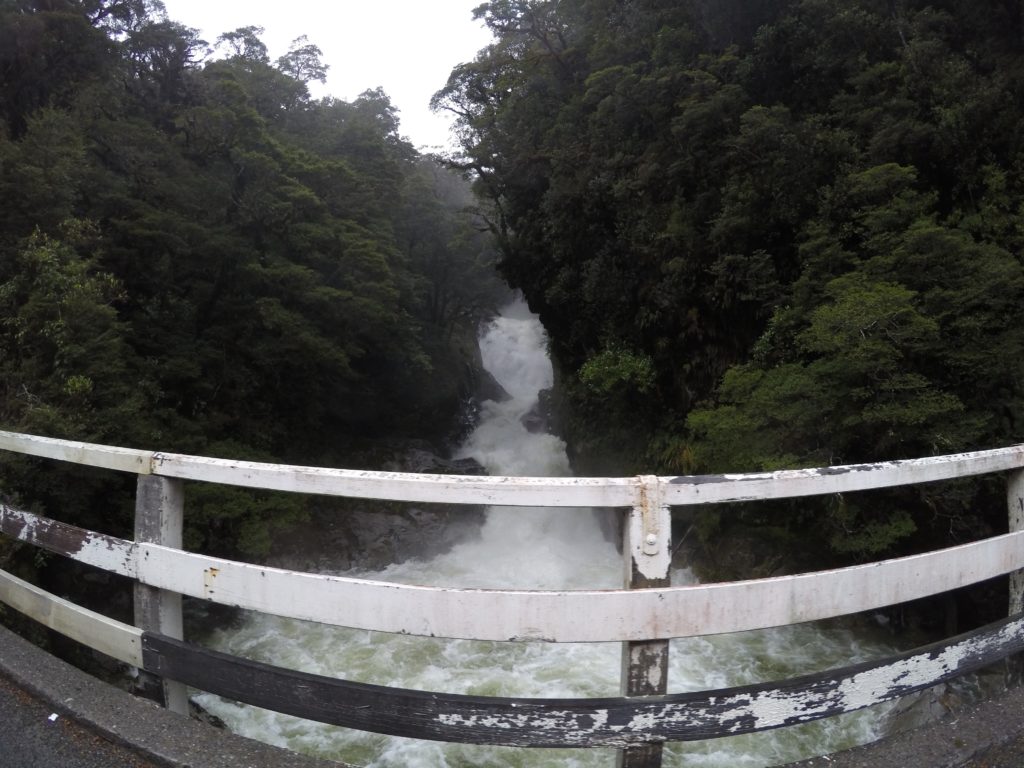
En route to Milford Sound, keep in mind, the last gas station, medical assistance, and groceries is in Te Anau, which is 120 km away from Milford Sound. Also, Highway 94 (Milford Road) is intermittently closed due to weather (please check the weather and traffic conditions before you leave Te Anau). Luckily, the road was open today. Before accessing the fiord, we drove through the Homer Tunnel, which opened in 1954. The Homer Tunnel is a 1.2 km single narrow lane tunnel through a mountain.
After driving 6.5 hours, we arrived in Milford Sound, in the Fiordland National Park with plenty of time to spare before the rescheduled cruise. We picked up our tickets for the Southern Discoveries - Encounter Nature Cruise (unfortunately the underwater observatory was closed due to maintenance). We passed the time over coffee and walking along the newly constructed wooden walkway leading to the cruise departure point.
The cruise was a 16 km trip through the fiord out to the Tasman Sea and back (just over 2 hours). The best part of cruising today, was the heavy rains fuelled the waterfalls and rivers flowing down the mountains and rock faces! You definitely need to go to Milford Sound in the rain or shortly after to have an amazing view of the waterfalls. Considering Milford Sound sees about 200 days of rain each year (7-9m of rain), it shouldn’t be hard to accomplish this. The more difficult feat will be going on a day where there is rain, but also good visibility without too much fog. For the more adventurous traveller, you can stand on the bow of the ship as they pull in directly under a waterfall. *Caution, you will get wet; really wet! Rain jackets were provided and it looked fun, but remember to protect your cameras and electronics.
Another interesting feature of the fiord is the tree avalanches that happen from time to time. The trees grow along the rock face with vast shallow flat root systems that branch out with the surrounding tree roots interconnecting over hundreds of years. Eventually, the rain plus the weight of the trees cause a tree avalanche whereby an entire strip along the rock face tumbles into the fiord displacing the water.

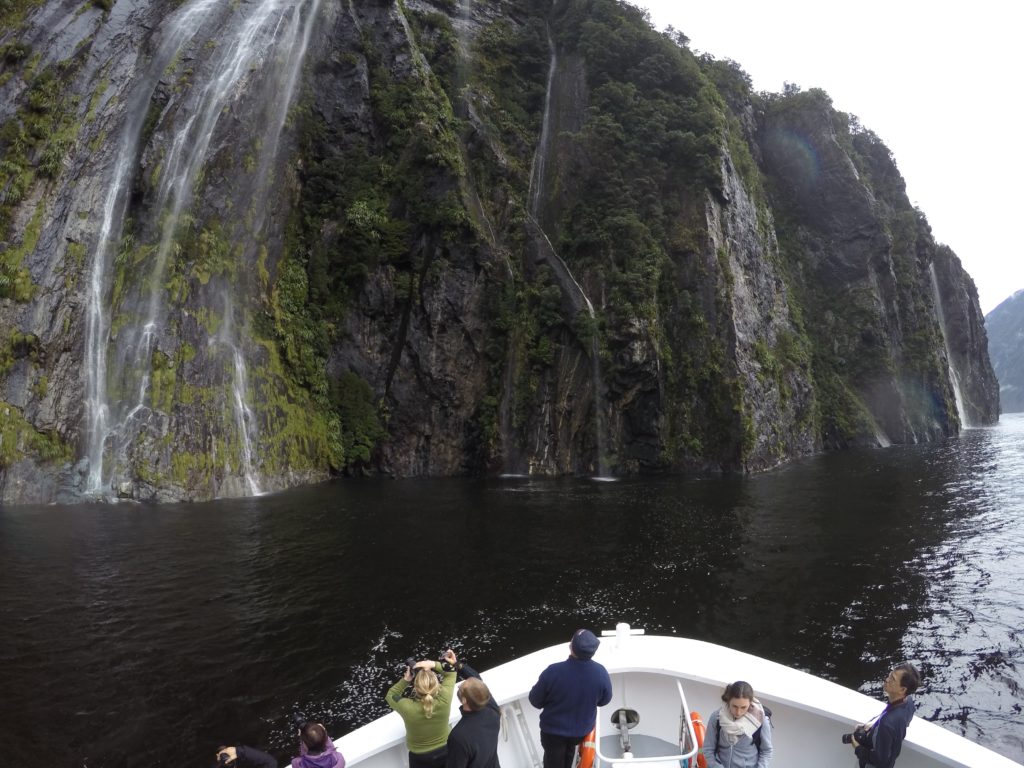
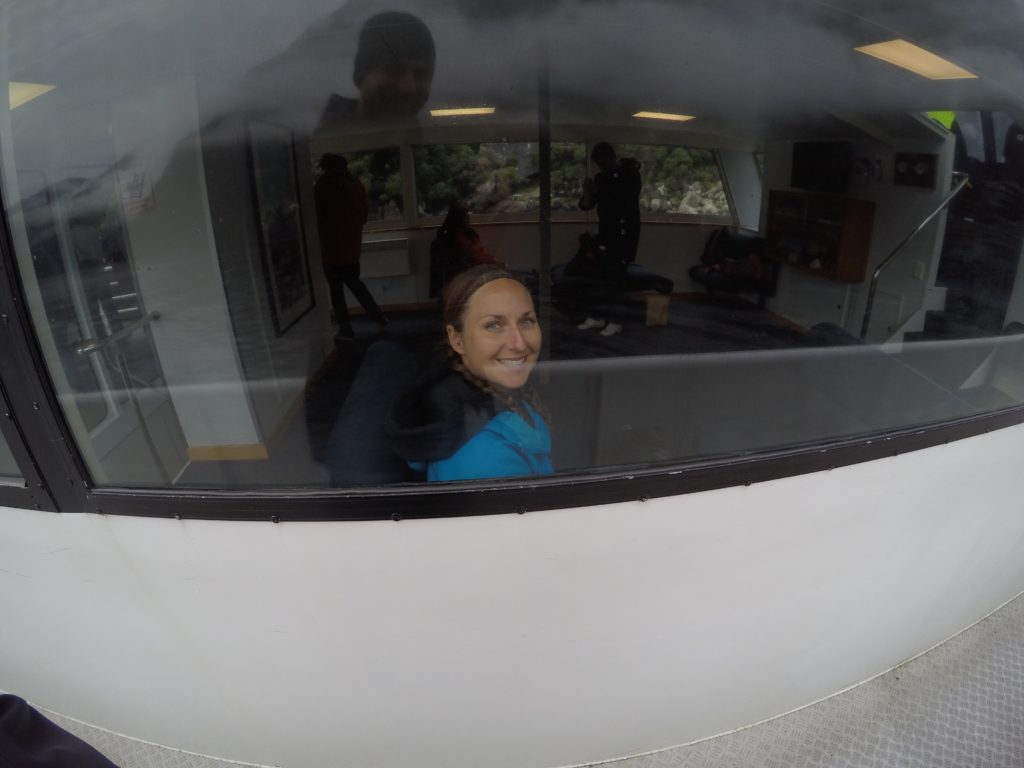
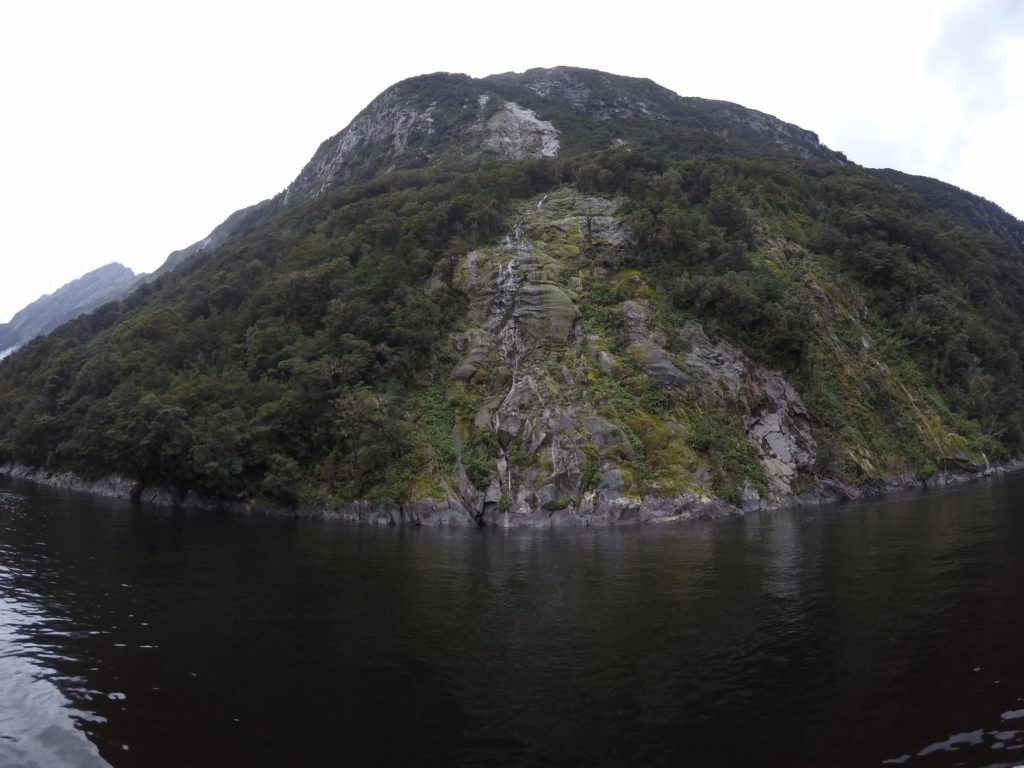
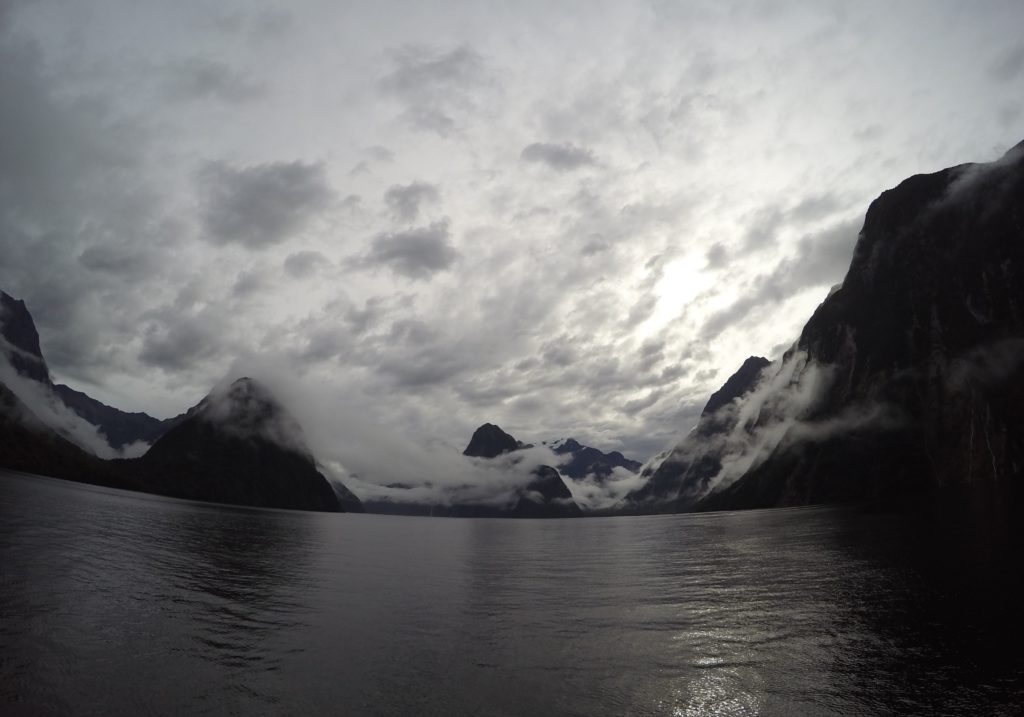
There are two waterfalls that are active all year long: Lady Bowen Falls and Stirling Falls. Bowen Falls is used for hydroelectricity to power the surrounding area. The rest of the waterfalls are powered by the annual rain or lack thereof.
Unfortunately, we were not lucky enough to see any fur seals, penguins, or dolphins today, but we were told that you may catch of glimpse of them on the tours. And if the weather permits you should definitely consider the kayaking in Milford Sound as it would give you an up close perspective of the fiord.
The drive back to Queenstown was 5 hours (not 3.5 hours Google Maps) in good weather. Milford Sound was a highlight and likely the most memorable part of our NZ trip. Thanks for the suggestion Kristi!

2016.05.10 Queenstown
Months ago on paper, we had planned to drive to the Franz Josef glacier from Queenstown. The lower part of NZ South Island’s West Coast is glacier country; rivers of ice with guides essential to avoid injury and tours typically involving heli-hiking that conclude with thermal soaks in Glacier Hot Pools. Incredible right? However, after 9 straight days of driving, we felt exhausted and days were starting to blur together. We needed downtime more than we needed to see the glacier. Something we didn’t realize, something nobody told us, is how tiring travelling and exploring is. It is not the perpetual holiday as some might think. So… the compromise, was to explore Queenstown, and all it has to offer, on foot.
It was impossible to miss the Cookie Muncher Cookie Bar store with the bright red Cookie Muncher character. A well known New Zealand brand of cookies, with plenty to look at and purchase inside the shop. We liked the post card cookie that you can mail almost anywhere in the world.

Andrew was tempted to indulge in cookies, until he realized there was a Starbucks. Andrew’s favourite indulgence in Canada - Caramel Macchiato. NZ Starbucks had a slight variation; offering a Burnt Caramel Macchiato. We would later come across Australia’s version - Toasted Caramel Macchiato. Needless to say, if it has caffeine and caramel, Andrew loved it!
Caffeine fix in place, the next stop was for morning gelato. With a little research we learned Mrs Ferg Gelateria and the bakery next door was the place to be. The bakery was packed! We appreciate and use TripAdvisor often, but you don’t need TripAdvisor to tell you you’ve found a popular spot when there is a line up out the door.
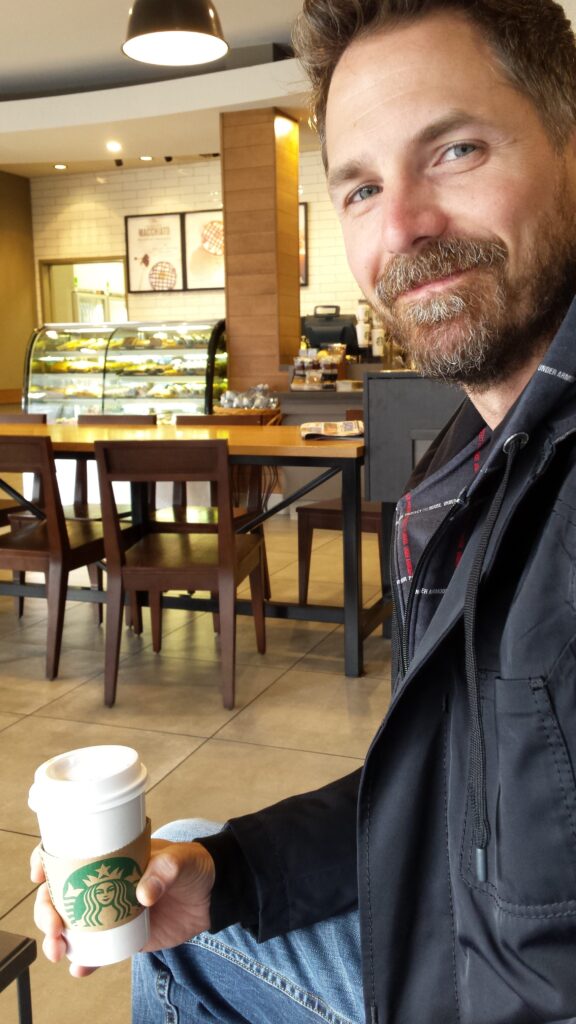


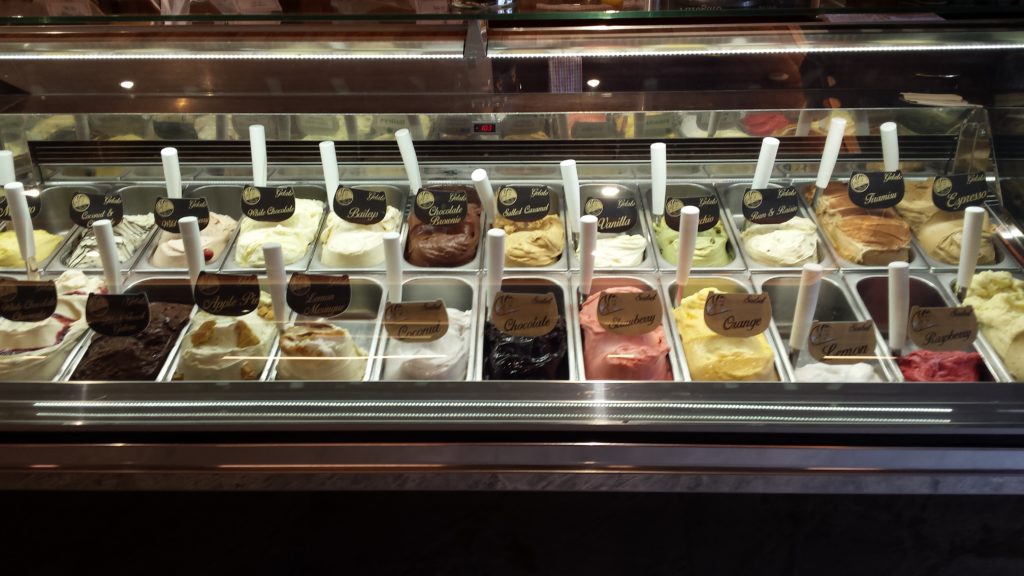

After walking through the downtown core, we drove up to the Skyline Queenstown to have a peek. There are tons of options available: gondola rides, dinner at the restaurant at the top (Stratosfare Queenstown Restaurant included with a gondola fare), luge, mountain biking, and hiking to the top (or back down). We decided that we wanted to do something else, but some of these would be on our agenda if we returned.
We went into the i-Site Queenstown location to gather some inspiration for the rest of our day. We decided that we would do our first winery tour and chose Gibbston Valley Winery. Gibbston Valley has a wine cave and tasting tours, a restaurant, a gift shop, Gibbston Valley Cheesery, and bike rentals. There is nothing better than getting tipsy and hopping on a bicycle! Been there, done that... but maybe that isn't the most responsible thing to do.
We decided to join a wine tour ($15 NZD/person) that had just begun, and caught up to the group by the grape vines before moving into the wine cave. The 1400 cubic metre wine cave was made by blasting into the mountain behind the vineyard. It was the first wine cave in New Zealand and it is still the largest. The wine cave was a unique experience and a great place to drink and learn about wine.



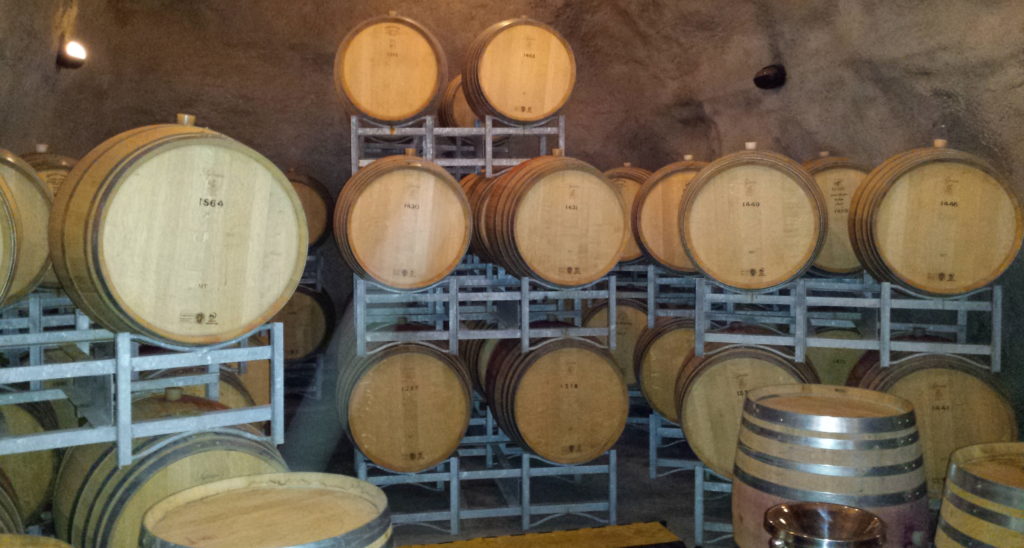
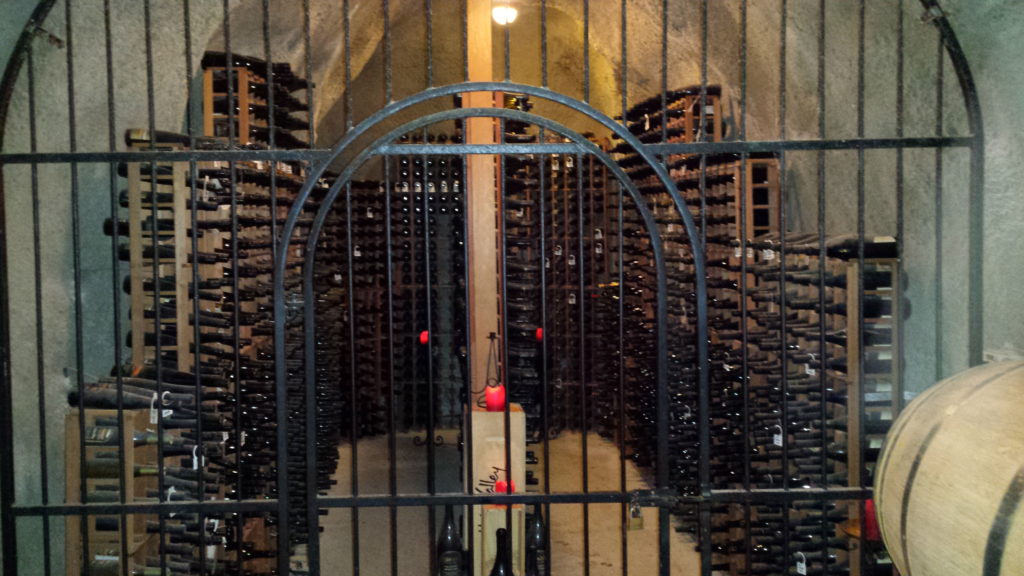
We tried some newer release wines and strolled around the wine cave before walking back into the Cellar Door to find out about the wine club and distribution to Canada. Gibbston Valley unfortunately is not distributed in Ontario or by the LCBO (Liquor Control Board of Ontario). For the readers that are not aware, the LCBO holds a monopoly on all alcohol sold in Ontario and they get to decide what can be imported for distribution.

We decided to stop at AJ Hackett Bungy on the way back to Queenstown. Neither Krissy nor I had enough liquid courage to even want to come remotely close to jumping. This was the site of the world’s first bungy jumping on the Kawarau Bridge (1988). The facility was pretty impressive and on top of bungy jumping there was also a zip line. There are a few cameras recording every jump to well document your bravery or lack thereof. After living vicariously through several jumps, we made our way back to Queenstown.
2016.05.11 Queenstown to Christchurch - Flight to Sydney Australia
May 11th was our last day in New Zealand, and we drove from Queenstown to Christchurch to catch our flight to Sydney, Australia. The driving in New Zealand is incredibly picturesque, the roads are forever winding, and the topography mountainous. Just remember to give yourself extra time while driving in New Zealand.
We paused roadside to share a healthy picnic lunch and deplete remaining groceries; a tactic that saved tons of money while travelling. Pair this with hotels or rentals with kitchen amenities to save even more money. Did you know you can hard boil eggs in a kettle? How about grilled cheese sandwiches made with an iron? And restaurant condiment packages are typically free.
We averaged $51.37 NZD/day on food.
By the time we reached Christchurch, the wind had picked up. We took a final spin around the city and experienced the displeasure of rush hour traffic paired with road construction as we tried to re-route and return our Apex rental car before departing for Sydney. Before the complimentary shuttle to the airport, we donated remaining groceries and we captured an odometer picture of our mileage. Grand total: 3815 km in 9 days (I don’t know what happened with our Instagram post… it says we drove more lol).
At the airport, before clearing security and reaching the departure gate, we obtained our Air New Zealand boarding passes, checked our baggage, and were stopped at Customs. The young female Customs Officer glanced my way, then starred at Andrew. We stood silently as she went back and forth between looking at him and his passport photo. Then, unexpectedly, we heard, “I don’t normally say this, but did you come all the way to New Zealand just to let yourself go?” Apparently she much preferred the clean shaven passport image versus the now slightly out of control beard Andrew was sporting. It was both awkward and hilarious… at least we cleared Customs!?!
By the time we reached the departure gate, boarding for the 6:30pm Air New Zealand flight to Sydney AUS had already commenced. Krissy was particularly nervous as many domestic flights had already been cancelled due to the windy weather conditions. I tried to convince the both of us that our plane must be bigger and stronger and flying in a different direction away from any bad weather… right?
Wrong!
Without any wait time on the tarmac, our airplane commenced takeoff early. The plane seemed to fight the wind as it attempted to take off; wheels lifted and we started to climb in the air only to feel the wind pushing the plane sideways… the plane went up, then as if on stairs, seemed to aggressively drop back down a few steps before trying to climb again. Krissy was completely panicked and I was worried. We found ourselves starring into each other’s eyes in utter disbelief… Krissy fearful for death and I unable to console her. Breathe… just breathe. The plane turned sharply and pushed upward; this was the worst turbulence we had ever encountered. The flight attendants were strapped in and the seatbelt sign never turned off. There was no liquor to dilute the horrified emotion of this unnerving flight. Take a breath… just breathe. Even at cruising altitude, there was turbulence; Krissy was fixated on the frequent flashes of lightning against the dark sky. Unexpectedly, the wind changed direction forcing the pilot to make an announcement… the pilot calmly explained the situation and her plan. Nearing Sydney, the pilot made a rapid corkscrew-like descent and we felt the plane swinging side to side as we approached the runway before the plane’s wheels firmly touched down on Australian tarmac. Tears streamed down Krissy’s relieved face… Nightmare over thanks to the heroic anonymous female pilot. Thank you Air New Zealand for getting us to Australia safely!
…but would I be able to get Krissy on another flight to return home to Canada in 3 months?
[CLICK HERE] to continue reading about Australia